Factory-Attached Gateway Support
This topic guides technicians through the hardware components and troubleshooting details for the Factory Attached Advanced Gateway (part number: A0005495703), installed on the models listed on this page.
The Advanced Gateway enables remote control and monitoring of backup power equipment leveraging Generac Link Manager, our cloud solution for industrial IoT connectivity. This topic offers wiring and hardware details as well as some troubleshooting steps for a complete setup that enables continuous communications and remote access.
Advanced Gateway Commissioning
This topic details the hardware components and installation steps needed to commission an IoT-enabled generator and associated equipment.
Be sure to check out our FAQs for answers to common questions.
Tools Needed
Technicians should bring the following hardware and software to the installation.
On Hand | Hardware and Documentation |
Access to Genlink software (specific to Generac controllers) | |
Factory-attached harness details are available here. | |
Modbus master simulator such as Modscan32 or Modscan64 | |
Windows laptop with ethernet port | |
Equipment controller documentation | |
USB to RS485 converter | |
USB to RS232 converter | |
Ethernet (CAT5) cable | |
Wireshark software installed on laptop—free download from internet | |
Multimeter with AC/DC voltage, AC/DC current, and resistance measurement capability |
Components
Be sure to verify that the following hardware was included with the generator delivery.
Yes/No | Hardware |
(1) Communication gateway (Generac part number: A0005495703) | |
(1) 3-in-1 cellular and GPS antenna with pigtail | |
(3) Antennae extenders | |
(1) Verizon SIM card (activated and installed) | |
Factory-installed communication and power harness | |
Weather-proofed gateway enclosure |
Other checklist items for Site Deployment include verifying voltage and the condition of circuit fuses. Please follow the steps in this table.
Pass/Fail | Site Deployment Prerequisites |
| |
| |
| |
|
In the event that any of parts arrive damaged, please contact Support to open a ticket and request needed replacements.
Gateway Replacement Installations
If installing a gateway replacement, please follow these guidelines:
Power down gateway by removing inline harness fuse.
Remove all terminal blocks and antennae connected to the old gateway.
Remove gateway from enclosure or din rail mount.
Make note of the new gateway serial number.
Install new gateway in enclosure or din rail mount.
Reconnect all terminal blocks and antennae to new gateway.
Restore power to gateway by reinstalling inline harness fuse.
Powering Up Gateway
The necessary connections, inputs, and ports located on equipment panels are described in this section. Once the terminal blocks are connected to the gateway, the device may be powered on. To proceed:
Connect power terminal block to the gateway.
Power the gateway.
Front Panel

Front Panel Connections and Ports
Descriptions for port indicator lights, inputs, and connections on the front panel are listed in this table.
Front Panel Functions for the Gateway
Front Panel Functions | Description |
PWR | LED indicates power to the Gateway:
|
WARN | On or blinking indicates an error condition. Off inidicates normal activity. |
STATUS | LED indicates device status:
|
NET | LED indicates if there is an active cellular connection:
|
Programmable 1 | Future use |
Programmable 2 | Future use |
Programmable 3 | Future use |
Programmable 4 | Future Use |
USER Button | Button to enable diagnostic features (for future use) |
USB | USB Port |
ETH1 | Ethernet Connection via static IP |
ETH2 | Ethernet Connection via DHCP |
SD Card | Unused |
Reset | Tech support use only |
Left Panel
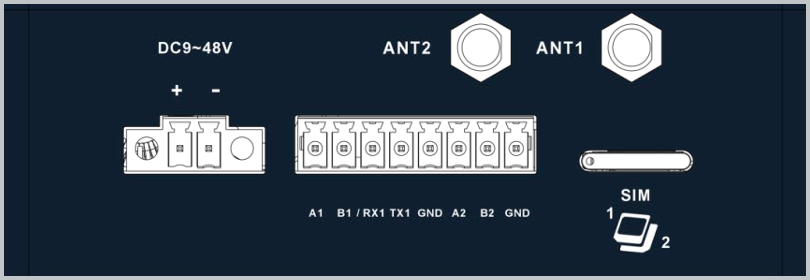
Left Panel Connections and Inputs
If the SIM card has been inserted into position 2, move to position 1 then test signal strength before proceeding.
Descriptions for ports and connections on the left panel are listed in this table.
Left Panel Functions | Description |
DC9-48V + | DC Power Positive |
DC9-48V - | DC Power Negative |
Ant2 | 4G Diversity Antenna |
Ant1 | 4G Primary Antenna |
A1 | Unused |
B1 | Unused |
RX1 | Serial RS-232 Receive |
TX1 | Serial RS-232 Transmit |
GND | Serial RS-232 Ground |
A2 | Serial RS-485+ |
B2 | Serial RS-485- |
GND | Serial RS-485 Ground |
SIM 1/2 | SIM Card slot (x2) |
Some factory-attached connectivity gateways initially shipped with the cellular antenna disconnected from the gateway. The issue has been corrected for new shipments. For existing inventory, please confirm that the pigtails coming from the gateway enclosure are connected to the antenna cables as illustrated in the following diagram (Red > Red/Black and Blue > Blue). This will ensure the gateway has adequate cellular signal strength to communicate with the connectivity platform.
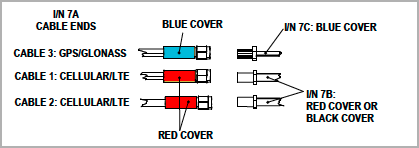
Connecting to Antenna Cables
Please refer to our knowledge base for further information on wiring and connections.
Right Panel
Connections and inputs are captured in the following images.
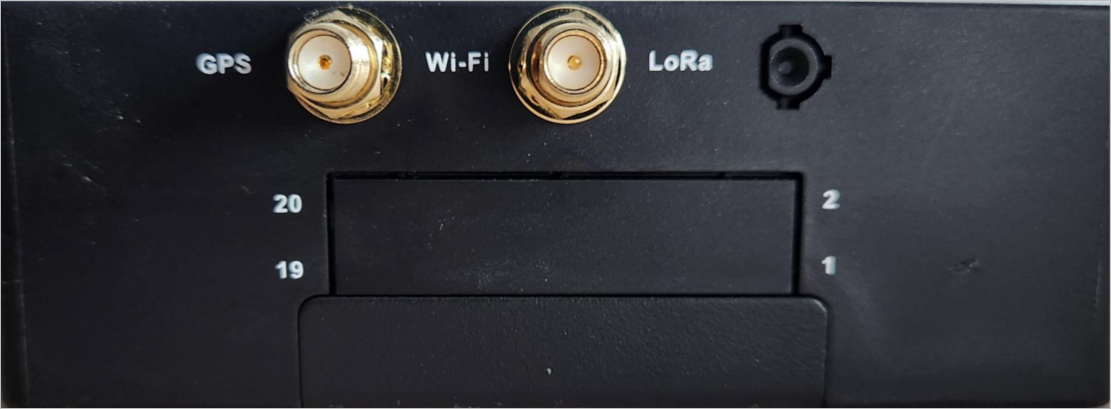
Inputs Photograph of Right Panel
Descriptions for connectors and inputs for the right panel are provided in this table.
Right Panel Functions | Description |
GPS | GPS antenna |
Wi-Fi | WiFi antenna |
LoRa | Not used (for long-range radio signals) |
Troubleshooting
Check this section to resolve any issues experienced while setting up the Advanced Gateway.
SIM Card Verification
Be sure to verify that the SIM card is in its proper location.
Power off the gateway.
To open the SIM card slot, a paper clip needs to be inserted in small hole located on card holder. Hole can be seen toward edge of extended holder in picture provided.
Verify that the SIM card on arrival is inserted in the primary slot, as depicted in the photo, with chip wiring facing up. A backup slot (as part of the same tray) is available for a Hologram SIM card. If specifically requested to do so by Support, insert the SIM into the second position with chip wiring facing down.
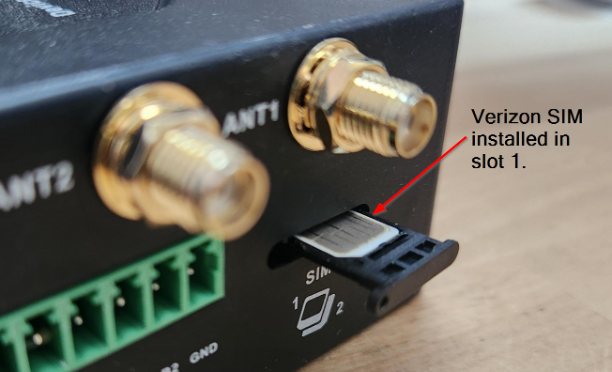
SIM Tray on Left Panel
If proper insertion of the SIM card is verified and the signal remains insufficient, use the extension provided to place antennae to a location with a stronger signal. Be sure to speak with a local facility contact to inquire about coverage in the facilities.
If the NET indicator light is blinking for more than 15 minutes, check Verizon’s coverage map at this external resource: https://www.verizon.com/coverage-map/.
Using a LAN-Based Internet Connection
For LAN wired internet connectivity, ports 443, 5671, and 8883 must be open for outbound traffic on the facility firewall, if applicable. The customer-provided Ethernet connection must be configured to assign the Generac Link gateway an IP address via DHCP.
Run network cable from customer’s nearest network infrastructure to a laptop.
Verify that the network cable has an active internet connection by opening a web browser and attempting to access http://www.google.com .
If laptop test is successful, connect Ethernet cable to ETH2 port on the gateway. If test is not successful work with facility IT to resolve.
Power off the gateway.
Remove SIM card(s) from the gateway.
Power on the gateway.
Wait for 10–15 minutes then check the Generac Link Manager portal for live data stream. If the live stream is not current, please contact Support.
A video call using Microsoft Teams may be needed in order to share your screen with a solutions engineer.
Changing Communication Option from Serial to Ethernet
Enable the Modbus TCP port on the controller.
Set the controller IP address in 192.168.3.x (that is, any value with the exception of 192.168.3.100).
Set subnet mask to 255.255.255.0.
Run ethernet cable and connect to generator controller Modbus TCP port as well as ETH1 port on Generac Link gateway.
Contact Support to reconfigure site for Modbus TCP communications.
If controller IP address cannot be changed due to site restrictions, please reach out to schedule a session with a Solutions Engineer.
If the technician does not have password to change communication setup on controller, reach out to the IDC master tech or to the generator support team.
If the technician does not know where to change the communication setup, reach out to the IDC master tech or generator support team.
Replacing an Existing Gateway
Remove power and serial connection terminal blocks, antennae connections, and any Ethernet or other cabling from the gateway to be replaced.
Remove existing gateway from enclosure.
Replace existing gateway with new gateway by reconnecting the terminal blocks, antennae, cabling, and installing in the harness and enclosure.
Data Values of N/A
There may be a gateway-to-network connectivity issue.
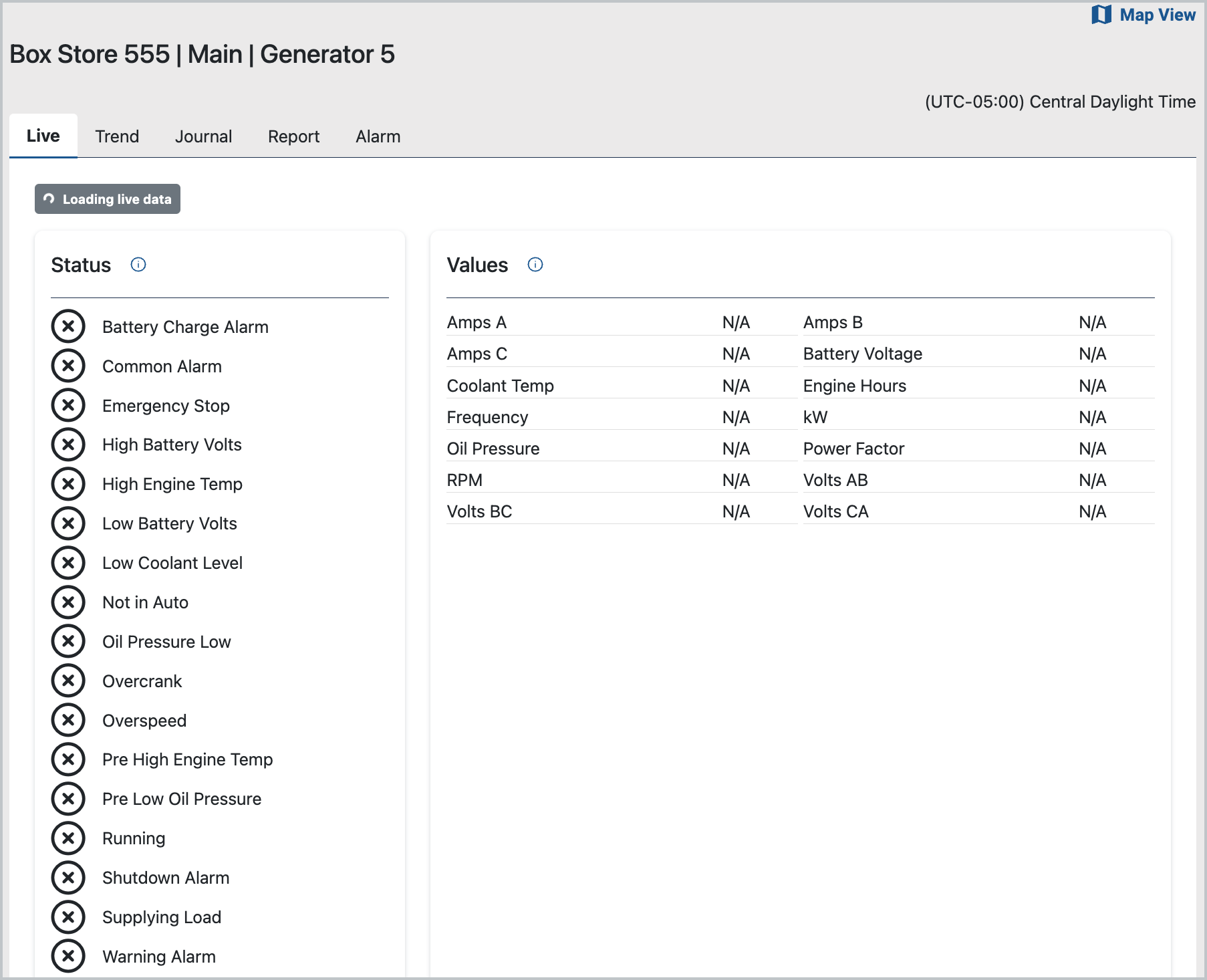
Possible Connectivity Issue
Steps to Resolve
Confirm that the device is on by checking the PWR light, which should be illuminated and solid (without blinking).
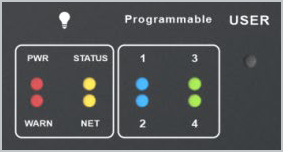
Power and Status Indicator Lights
If the PWR light is off, check red and black wire connections and voltage.
Confirm that the NET light is On. This light indicates if there is an active cellular connection and will blink while registering and illuminate (solid, without blinking) when connected. If NET light is off, confirm that antennae are firmly connected and move to a location with the best possible signal.
The included antenna extension cables can be used to move the antenna outside of the enclosure to improve the signal. If the light keeps blinking, be sure sure the antenna is connected to ANT1 and ANT2 ports of the gateway and the antennae are mounted to a place of maximum cellular coverage.
Cycle power to gateway by removing and re-inserting the inline harness fuse. Wait approximately one minute and check NET and signal lights again.
We also recommend that the onsite technician checks Verizon coverage at the site using Verizon’s coverage checker (https://www.verizon.com/coverage-map/). If necessary, determine if alternative carriers (for example, AT&T or T-Mobile) have better reception in the area. Be sure to reach out to local site contacts.
Values of -99 Populate Data Stream
A value of -99 indicates a Modbus serial communications issue.
Negative 99 (-99) Appears in Data Stream Values
To resolve this issue, be sure to take the following steps:
Check and compare the settings for the following with the controller-specific installation instructions.
RS232 Settings
Baud rate
Parity
Modbus address
For the DB9, be sure to disconnect then reconnect.
Modbus RS485 Settings
Baud rate
Parity
Modbus address
Modbus TCP Settings
IP Address: 192.168.3.2
Subnet Mask: 255.255.255.0
Default Gateway: 192.168.3.100
Confirm proper wiring connections between the gateway and controller.
Power cycle the equipment controller.
Be sure firmware version on PowerZone Pro Sync is 1.23.2 or higher.
Gateway and Controller Connections
Wiring for the gateway and controller panels are summarized in this table. Be sure to also refer to the Wiring and Harness diagrams.
Power Wires (H-/G-Panel, PZPS, G8601) | Power Wires (Gemini) | Power Wires (IGNT) | RS232 Communication Wires (H-/G-Panel, IGNT) | RS232 Communication Wires (Gemini) | RS485 Communication Wires (PZPS, G8601) |
|---|---|---|---|---|---|
Wire #0: Black color (Negative) | Wire #0: Black color (Negative) | Wire #12: Black color (Negative) | Wire #387: Orange w/White Stripe color (RS232 RX) | Wire #387A: Orange w/White Stripe color (RS232 RX #1) | Wire #392: Orange w/White Stripe color (RS485 A) |
Wire #13/218: Red color (Positive, Pre-fuse) | Wire #13/218: Black color (Positive, Pre-fuse #1 & 2) | Wire #4: Red color (Positive, Pre-fuse) | Wire #388: White w/Orange Stripe color (RS232 TX) | Wire #388A: White w/Orange Stripe color (RS232 TX #1) | Wire #393: White w/Orange Strip color (RS485 B) |
Wire #15F/220F: Black color (Positive, Post-fuse) | Wire #15F/220F: Black color (Positive, Post-fuse #1) | Wire #4G: Black color (Positive, Post-fuse) | Wire #389: Blue color (RS232 COM) | Wire #389A: Blue color (RS232 COM #1) | Wire #COM: Blue color (RS485 COM) |
Wire #15G/220G: Black color (Positive, Post-fuse #2) | Wire #387B: Orange w/White Stripe color (RS232 RX #2) | ||||
Wire #388B: White w/Orange Stripe color (RS232 TX #2) | |||||
Wire #389B: Blue color (RS232 COM #2) |
For needs requiring immediate assistance, contact Generac Support at:
Help center and knowledge base: https://support.energyservices.generac.com/
Registered users: Support login
